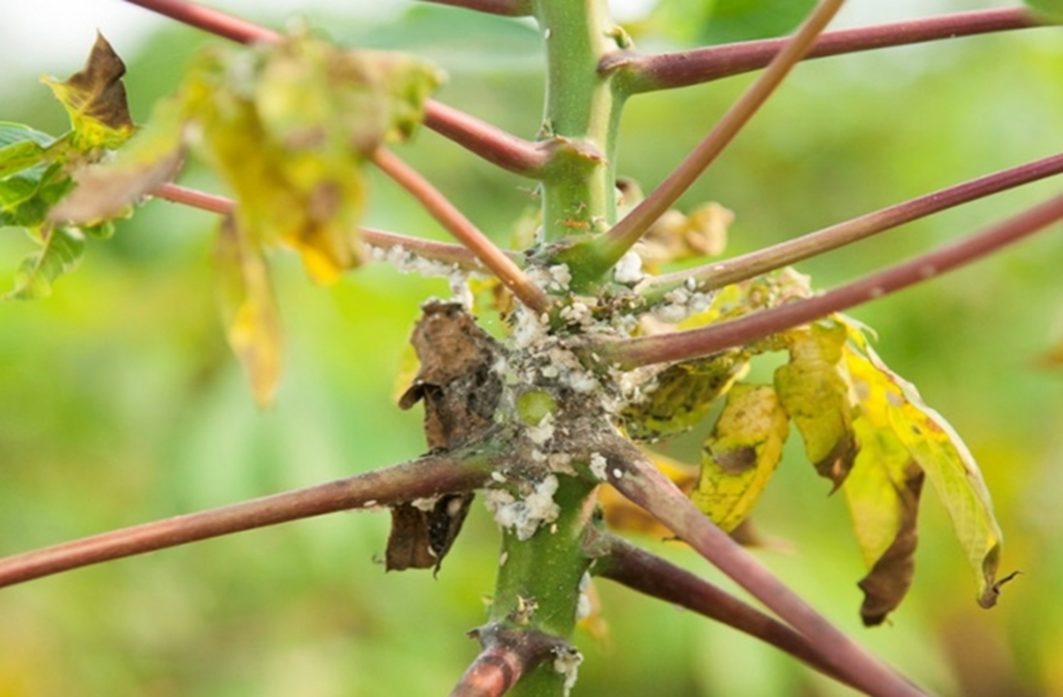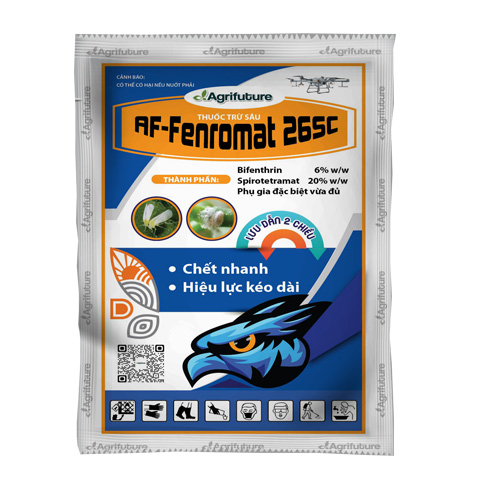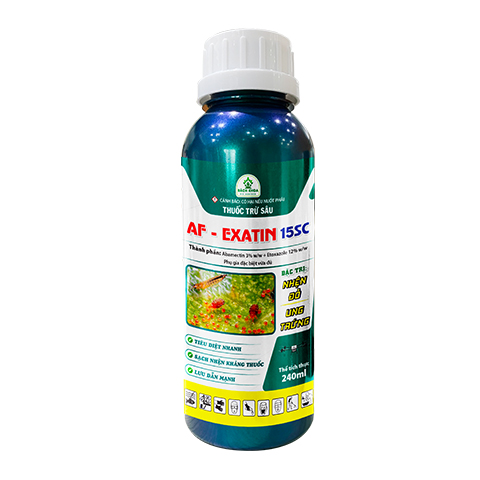In this article, Agrifuture has compiled preventive measures against common pests on potato plants. If you have any questions or need technical advice, please contact us using the information below.
Vietnam is one of the countries with a significant export volume of potatoes. In recent years, the situation of pest infestation has become increasingly complex, significantly affecting the productivity, quality, and economy of this crop. Let's explore the common pests found on potato plants and preventive measures with Agrifuture in the following article.
1.Pink wax scale on potato plants.

The pink wax scale insect thrives during dry months and periods of low rainfall.
Identification:
Juvenile scale: pink color with antennae at the head.
Adult scale: also pink, egg-shaped body covered with a white waxy layer. Developed legs, with short white waxy tufts along the body edges and tail.
Pathogenic Characteristics:
On leaves, the scale attaches to the underside, causing curling and yellowing. In high densities, entire leaves can fall off, leading to up to an 80% reduction in tuber yield. The pink wax scale insect symbiotically coexists with some ant species and can spread through them.
Control Measures:
Maintain a well-ventilated cassava garden. Apply balanced fertilization.
Protect natural enemies (ladybugs, lacewings, parasitic wasps...), introduce the parasitic wasp Apoanagyrus lopezi, utilize biological control agents to manage the scale.
Regularly monitor fields, eradicate scale colonies thoroughly, delineate and collect infected plants, spray plant protection products over the entire infected area and its surroundings.
Agrifuture recommends using AF - Fenromat 26SC for effective prevention and treatment of the scale.
• Information on AF - Fenromat 26SC:

Characteristics & Applications
AF - Fenromat 26SC is formulated from a unique blend of two advanced active ingredients with two separate, potent insecticidal mechanisms. The product directly impacts the peripheral nervous system and inhibits ACC, disrupting the lipid synthesis process in insects. Thus, it provides immediate efficacy even against pesticide-resistant pests and maintains effectiveness for several days after application.
Usage Directions
AF - Fenromat 26SC is registered for controlling bollworms on cotton plants.
Dosage: 500ml/ha. Mix 20ml with a 25-liter water tank.
Water volume: 450 - 500 liters/ha.
Timing: Apply when bollworms emerge (1-2 weeks old).
Density: Approximately 1-2 pests/plant.
Re-entry interval: 14 days.
2.Red Spider Mites on Potato

Red spider mite is a pest that tends to cause widespread damage, especially in sloping fields with poor water drainage or fields irrigated from trenches, making this pest difficult to manage. Currently, during the peak of the dry season, intense heat and drought conditions make it even more likely for certain pests, including red spider mites, to proliferate and thrive on potato plants.
Identification characteristics:
Adult red spider mites are very small, oval-shaped, about 0.5 mm long, reddish-pink in color, with 8 legs and move very quickly. Their eggs are very small, spherical, dark red in color. Young spider mites resemble adult ones, but they are pink and have 6 legs.
Symptoms of damage:
Red spider mites typically start causing damage on the undersides of older leaves, near the base, before gradually moving up to the younger leaves. When spider mite populations accumulate, they can damage both surfaces of the leaves, even the tender shoots, by piercing and sucking sap, creating streaks along the leaf veins. Initially, these streaks are yellow but later turn brown, dry out, and fall off. If the shoots are attacked, the plant stems may shrivel, leading to stunted growth.
Preventive measures:
Ensure fields are not allowed to become dry; irrigate them adequately and regularly using a sprinkler system or hose to control the occurrence and damage caused by spider mites. Protect natural enemies of red spider mites in the fields, such as ladybugs, etc. In cases where spider mites have proliferated and caused significant damage, Agrifuture recommends using AF - Exatin 15SC to quickly eradicate the harmful mites.
Information on the product AF - Exatin 15SC:

Characteristics and Uses:
AF - Exatin 15SC harnesses the power to eliminate sucking insects through two unique mechanisms. It inhibits the transmission of the gamma-aminobutyric acid nerve impulse, causing insects to cease feeding and oviposition immediately, while also suppressing chitin synthesis, hindering egg formation and the molting process. Thus, it can effectively control the entire life cycle from eggs, larvae, to adults.
Instructions for Use:
AF - Exatin 15SC is registered for the control of red spider mites on peanut plants.
Dosage: 400ml per hectare. Mix 12 - 15ml with a 25-liter water tank. Mix 1 bottle (240ml) with 400 - 500 liters of water.
Spray volume: 400 - 500ml per hectare. Spray when newly emerged harmful mites are present, at a density of about 3 - 5 mites per leaf.
Isolation period: 5 days.
Through this article, it is hoped that farmers have gained valuable experience in the process of caring for and preventing pest infestations correctly. If you have any questions or need advice on effective medications or biological products for treatment, please contact us via the information below.